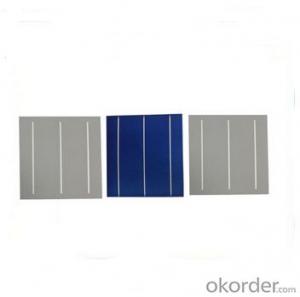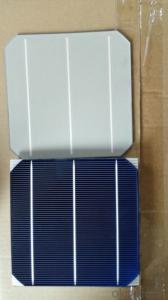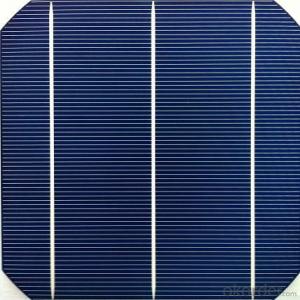Buy Flexible Solar Cells - Poly Solar Cell 156mmx156mm with Different Efficiency
- Loading Port:
- China main port
- Payment Terms:
- TT OR LC
- Min Order Qty:
- 100 pc
- Supply Capability:
- 10000000 pc/month
OKorder Service Pledge
OKorder Financial Service
You Might Also Like
Product Description:
1.Mechanical data and design
Format | 156 mm × 156 mm ± 0.5 mm |
Thickness | 210 μm ± 40 μm |
Front(-) | 1.5mm bus bars (silver),blue anti-reflection coating (silicon nitride) |
Back (+) | 2.5 mm wide soldering pads (silver) back surface field (aluminium) |
2.Temperature Coefficient of Cells
Voc. Temp . coef.%/K | -0.351%/K |
Isc . Temp . coef.%/K | +0.035%/K |
Pm. Temp. coef.%/K | -0.47%/K |
3.Electrical Characteristic
Efficiency (%) | Pmpp (W) | Umpp (V) | Impp (A) | Uoc (V) | Isc (A) | FF (%) |
17.25 | 4.197 | 0.524 | 7.992 | 0.62 | 8.458 | 80.03% |
17 | 4.137 | 0.524 | 7.876 | 0.619 | 8.353 | 80.01% |
16.75 | 4.076 | 0.522 | 7.81 | 0.617 | 8.286 | 79.73% |
16.5 | 4.015 | 0.518 | 7.746 | 0.613 | 8.215 | 79.73 |
16.25 | 3.955 | 0.515 | 7.683 | 0.61 | 8.144 | 79.61% |
16 | 3.894 | 0.512 | 7.613 | 0.608 | 8.075 | 79.31% |
15.75 | 3.833 | 0.51 | 7.534 | 0.605 | 8.058 | 78.62% |
15.5 | 3.772 | 0.508 | 7.453 | 0.604 | 8.02 | 77.87% |
15.25 | 3.771 | 0.505 | 7.35 | 0.604 | 9.997 | 76.83% |
15 | 3.65 | 0.503 | 7.271 | 0.604 | 7.989 | 75.64% |
14.5 | 3.529 | 0.499 | 7.067 | 0.604 | 7.988 | 73.14% |
14 | 3.407 | 0.499 | 6.833 | 0.604 | 7.833 | 72.01% |
4.Intensity Dependence
Intensity [W/m2] | Isc× [mA] | Voc× [mV] |
1000 | 1.00 | 1.000 |
900 | 0.90 | 0.989 |
500 | 0.50 | 0.963 |
300 | 0.30 | 0.939 |
200 | 0.20 | 0.920 |
5.Images:

6.FAQ:
What's the advantages of your products ?
1. High efficiency and High power.
2. Long-term electrical stability.
3. Lowest price and Fastest delivery.
4. Good quality and good service.
5. Bulk supply
6. Good Warranty
7. Big Sale
8. More than 25 years on the lifetime.
- Q: Can solar cells be used in indoor lighting applications?
- Yes, solar cells can be used in indoor lighting applications. However, their effectiveness may vary depending on the amount of sunlight available indoors.
- Q: How do solar cells perform in areas with frequent thunderstorms?
- Solar cells can still operate effectively in areas with frequent thunderstorms. While thunderstorms can temporarily decrease solar cell performance due to reduced sunlight exposure, advancements in solar technology have made solar cells more durable and resistant to extreme weather conditions. Additionally, solar cells can still generate electricity from diffused sunlight during cloudy or stormy days. Overall, solar cells can still be a viable and sustainable energy option in areas with frequent thunderstorms.
- Q: Can solar cells be used in recreational vehicles?
- Yes, solar cells can be used in recreational vehicles (RVs). Solar panels can be installed on the roof of an RV to harness sunlight and convert it into electricity, which can then be used to power various appliances and systems within the vehicle. This allows RV owners to enjoy the benefits of renewable energy while traveling and reduces the need for traditional power sources.
- Q: How do solar cells perform in areas with high levels of pollen allergies?
- Solar cells can generally perform well in areas with high levels of pollen allergies. While the presence of pollen might lead to some dust accumulation on the surface of the solar panels, it does not significantly impact their performance. Regular cleaning and maintenance can help ensure optimal efficiency of the solar cells, even in areas with high pollen levels.
- Q: Can solar cells generate power at night?
- No, solar cells cannot generate power at night as they rely on sunlight to produce electricity.
- Q: Can solar cells be used to power parking meters?
- Yes, solar cells can be used to power parking meters. Solar cells convert sunlight into electricity, making them a sustainable and environmentally friendly power source for various applications, including parking meters. By harnessing solar energy, parking meters can operate independently, reducing the need for frequent battery replacements or connection to the electrical grid.
- Q: Can solar cells be used in medical devices?
- Yes, solar cells can be used in medical devices. Solar cells can provide a renewable and sustainable source of energy for various medical devices, such as remote monitoring systems, wearable devices, and even implantable devices. They can help eliminate the need for frequent battery replacements and provide continuous power supply, making them particularly useful in remote or resource-limited areas.
- Q: How much do solar cells cost?
- The cost of solar cells can vary depending on various factors such as the type and size of the system, installation requirements, location, and quality of the panels. On average, residential solar panel systems can range from $10,000 to $30,000 or more. However, it is important to consider long-term savings on electricity bills and potential government incentives that can offset the initial investment.
- Q: My solar cells are broken, can I just buy one and replace it?
- No, you just can not do properly
- Q: What is the role of solar cells in powering water pumping systems?
- Solar cells play a crucial role in powering water pumping systems as they convert sunlight directly into electricity. This renewable energy source eliminates the need for traditional power sources and reduces the reliance on fossil fuels, making water pumping systems more environmentally friendly and sustainable. Additionally, solar cells provide a reliable and cost-effective solution, particularly in remote areas where access to electricity may be limited, ensuring that water can be pumped efficiently for various applications such as irrigation, agriculture, and domestic use.
Send your message to us
Buy Flexible Solar Cells - Poly Solar Cell 156mmx156mm with Different Efficiency
- Loading Port:
- China main port
- Payment Terms:
- TT OR LC
- Min Order Qty:
- 100 pc
- Supply Capability:
- 10000000 pc/month
OKorder Service Pledge
OKorder Financial Service
Similar products
Hot products
Hot Searches
Related keywords




























